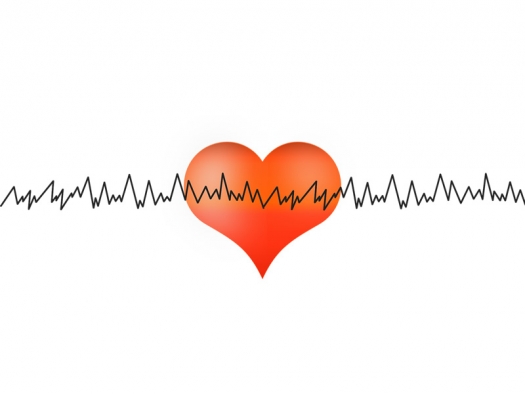HeartBeatIllustration.jpg

Illustration by Artsss / Pixabay License
Imagine listening to your favorite album or playlist. Every song sounds a little different. Some tracks are more upbeat and energetic; others might be slower and more melancholy. Just like songs vary in tempo to match the meaning behind them, a healthy heartbeat changes its tempo to match our physical and emotional environment.
Conventional beliefs around heartbeat imply that it's like a metronome – always beating at the same rhythm unless we’re exerting ourselves or doing some physical exercise that elevates it. This belief undermines the complex nature of our biology.
Heart rate variability (HRV) is the variability or spacing between each heartbeat. It might come as a surprise to hear that you actually don’t want the timing in between each heartbeat to be totally consistent. In fact, the most consistent HRV would be a flat line and nobody wants that!
Complexity Is Health
Rainforests are complex ecosystems with a high degree of biodiversity, which is what makes them resilient. For example, if a particular threat affects one species of plant within a rainforest, there is so much diversity that the ecosystem isn’t negatively impacted. A cornfield monocrop is the opposite, it can’t adapt when faced with challenges. If a threat affects a monocrop, that’s it – the whole harvest is destroyed.
The same is (relatively) true for your heart rate. A high HRV means it can adapt and respond to stress with more resilience, which means less cortisol (your main stress hormone), less inflammation, and healthier aging.
What controls these changes in your heart rate? Your vagus nerve, the longest cranial nerve that runs from the base of your head down to your gut, innervating your heart, intestines, and other organs along the way.
The Road to Vagus
Your vagus nerve regulates your psycho-spiritual-emotional well-being. It is responsible for turning off your stress response (your sympathetic nervous system) and activating your relaxation response (your parasympathetic nervous system).
This system is also deeply connected to your HRV. Having a high HRV means you can more easily respond to both stressors and times of relaxation – you can bounce back and forth more effortlessly. Another name for this is vagal tone.
The problem is most of us are in a state of constant stress and hyper-responsiveness to our surroundings, and very few of us know how to hit the pause or reset buttons. This failure to self-regulate (your body’s ability to sense its environment to tell your brain you’re okay) is a sign of low HRV.
How To Increase Your HRV
Here are some of my best strategies to increase your HRV:
- Exercise. Aim for three 45 minute moderate-intensity exercise sessions per week, as tolerated. Try walking, yoga, jogging, hiking, swimming, or participating in sports or games – find something appropriate for your fitness and health level. If possible, mix in strength training two to three times a week.
- Breathing exercises. Your breath and heart rate are intimately connected. When you inhale, your heart rate speeds up and when you exhale, your heart rate slows down. Try alternate nostril breathing. Alternate nostril breathing is a yogic breath control practice. In Sanskrit, it’s known as nadi shodhana pranayama. This translates as “subtle energy clearing breathing technique.” This type of breath work can be done as part of a yoga or meditation practice. Alternate nostril breathing can also be done as its own practice to help you quiet and still your mind. Box breathing, also known as square breathing, is a technique used when taking slow, deep breaths. It can heighten performance and concentration while also being a powerful stress reliever. It’s also called four-square breathing. See how it affects your heart rate between breaths.
- Meditation. Meditation increases our interoception, calms the mind, and reduces anxiety. One study found that just 5 minutes of mindfulness meditation a day can significantly improve HRV. Mindfulness meditation has beneficial effects on brain and body
- Yoga. I love yoga because it marries mindfulness with meditation and your breath, which all directly affect your HRV. Studies support regular yoga practice with an increased vagal tone and HRV.
- Good quality sleep. Snoring, sleep apnea, mouth breathing, and insomnia are all signs of low HRV. Some simple tips to help improve sleep are:
- Cut out alcohol, especially before bed. I don’t drink often, but I’ve noticed from wearing my Ōura ring (a device that monitors your sleep, HRV, and more) that the occasional alcoholic beverage disrupts my sleep and puts my HRV in an unfavorable zone.
- Don’t eat big meals right before bed. Give yourself at least two hours between your last meal and bedtime.
- Eat a whole foods diet. An ultra-processed Standard American Diet (SAD) disrupts your sleep and is linked to lower HRV. Eating an anti-inflammatory diet rich in omega-3 fats, polyphenols, B vitamins, prebiotic fibers, and probiotic foods increases HRV.
- Try mouth taping. Nose breathing increases nitric oxide, the molecule that relaxes your blood vessels and increases circulation. High levels of nitric oxide are associated with having a high HRV. If you know that you’re a mouth-breather when you sleep, try a special tape made to encourage you to breathe through your nose.
If you’re interested in tracking your HRV, the best and most accurate way to do it is through a wearable device like WHOOP or the Ōura ring. You can also check and monitor your HRV using an Apple Watch if you have one. If you want to learn about how to create physiological coherence between your mind and body, HeartMath offers a unique combination of technology, learning programs, and coaching to support your HRV and heart-brain connection.
A high HRV is linked to better resilience to stress, physical fitness, sleep quality, and all-around health. Focusing on ways to improve your vagal tone and increasing HRV allows you to more effortlessly respond to all that life throws at you. It helps you to better regulate your internal environment to match your external environment, which is critical for optimal health and aging.


